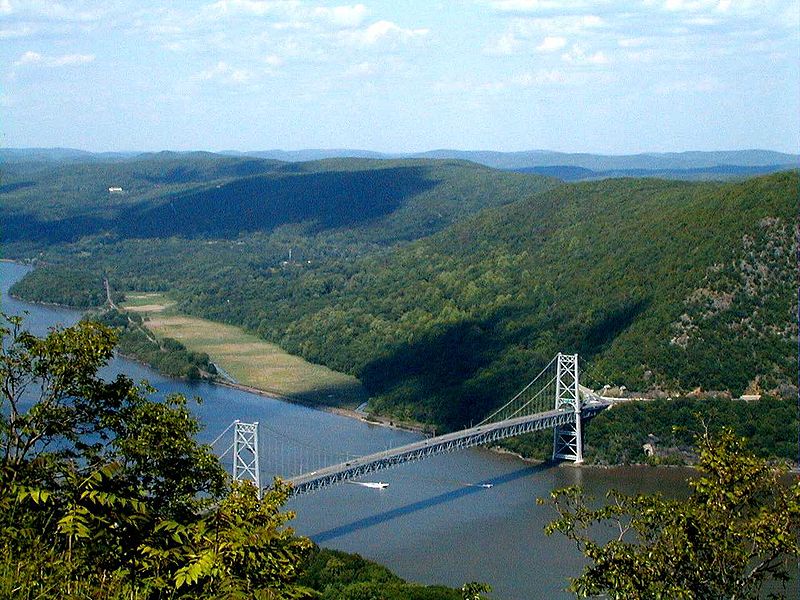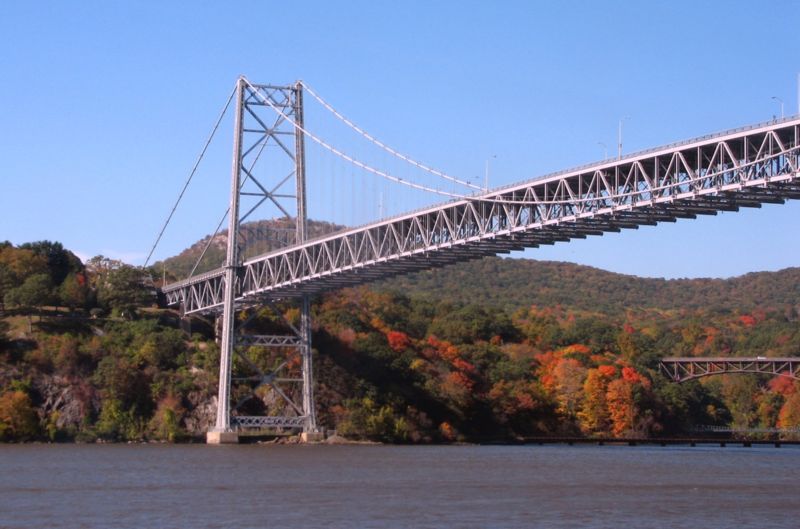| |||||||
Europe
North AmericaSouth AmericaAsiaAustralia and OceaniaAfrica |
Смотрите также: Bear Mountain Bridge The Bear Mountain Bridge is a toll suspension bridge in New York State, carrying U.S. Highways 202 and 6 across the Hudson River between Rockland and Westchester counties. From the time of its completion in 1924, it held the record for the longest suspension bridge span in the world for 19 months, until it was surpassed by the Benjamin Franklin Bridge in Philadelphia.
Bear Mountain Bridge Carries 2 lanes of US 6/US 202 and Appalachian Trail Crosses Hudson River Locale NW of Peekskill, NY Design Suspension bridge Longest span 1,641 ft (497 m) Total length 2,255 ft (687 m) Width 48 ft (15 m) Clearance below 156 ft (47 m) Opening date November 27, 1924 History Hudson Highland Suspension Bridge Plans for a bridge at the site had been made as early as 1868. The following year, the New York Times reported that a contract had been signed and construction would "speedily commence" on the "Hudson Highland Suspension Bridge" between Fort Clinton and Anthony's Nose. The intent was to carry a railroad toward Derby Connecticut, to supply coal and iron for industry in the lower Naugatuck Valley. The surface of the bridge was to be 150 feet (46 m) above high tide. In 1871 the newspaper reported that capital of $2.5 million had been raised and construction was expected to begin in 1875. In 1887, reports said the bridge would be finished in two years. By 1889, "work on the anchor pits was progressing rapidly." The story again resurfaces in 1896, when the Hudson Highland Bridge and Railway Company reportedly filed for incorporation with capital of $84,900. The company was described as a reorganization of the former Hudson Suspension Bridge and New England Railway Company, which at some point included steel magnate Andrew Carnegie on its board. Much of this period coincided with the so-called Long Depression, including stock market crashes called the Panic of 1873 and Panic of 1893. A charter for construction of the bridge expired in 1916. Bear Mountain Hudson River Bridge Company In March 1922, the state Legislature authorized creation of the private Bear Mountain Hudson River Bridge Company to complete the project, including a three-mile (5 km) approach road from the Albany Post Road north of Peekskill. The 11-member board of directors included financiers E. Roland Harriman and George W. Perkins. A $4.5 million bond issue was completed in April of that year through the Harriman banking and brokerage firm. Under the 1922 charter, ownership of the bridge was to revert by 1962 from the bridge company to New York State, which also had the right to acquire the bridge at any time. New York State Bridge Authority Ownership was transferred to the New York State Bridge Authority in 1940 and the toll was reduced to a flat rate of 50 cents per automobile. In 1982 the bridge and its then-abandoned original toll house a mile away on the Peekskill approach road on Route 6 and 202, were added to the National Register of Historic Places.
Maintenance innovation The Bear Mountain bridge was used to develop and test a new material designed to lower the cost and environmental impact of bridge cable maintenance. For over 100 years, a red lead paste material was used to seal the strands of bridge cables to prevent moisture intrusion. The lead-based material, an environmental hazard, was also prone to drying out and cracking in a few years. During routine inspections, bridge cables are unwrapped and wedges are used to separate the individual stands. Inspectors look for signs of moisture and corrosion throughout the cable. In the 1990s engineers experimented with several materials on a small section of the cables of the Bear Mountain Bridge. After a year the test areas were reexamined and one polymer-based, non-toxic paste material was found to be superior. The bridge cables were then rewrapped in 2000 using the material. The cables were found to be free of additional moisture or corrosion in a 2007 inspection. New York State Bridge Authority chief engineer William Moreau is hopeful that the new material will lengthen the life of the cables, and lower the need for inspection and maintenance. Comments: 0 |
|
|||||








































